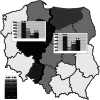Chlamydia prevalence in Polish pig herds
- PMID: 27174765
- PMCID: PMC9150455
- DOI: 10.1017/S0950268816000868
Chlamydia prevalence in Polish pig herds
Abstract
Chlamydiae are frequently encountered intracellular Gram-negative bacteria. In pigs, these bacteria in combination with other pathogens contribute to the induction of a multi-aetiological syndrome. One of the major characteristics of Chlamydia spp. is their ability to cause prolonged, often subclinical infections. While the economic consequences of Chlamydia spp. infections in pig farms are not fully established, we know that reproductive disorders and other syndromes correlated with Chlamydia infection can lead to financial loss as a result of a reduction in pork production. Additionally, Chlamydia spp. presents a potential zoonotic hazard, therefore determining the prevalence of Chlamydia in pig populations is critical. In the present study 97 pig herds from Poland were involved. To determine the prevalence of Chlamydia PCR and CFT tests were used. In total 797 vaginal samples, 797 conjunctival samples, and 235 serum samples were collected and tested. The study took place from 2011 to 2014. We found Chlamydia spp. present in 71·2% of all tested farms. The percentage of animals testing positive on any given farm varied from 20% to 100%.
Keywords: Chlamydia; PCR; prevalence; serological test; swine.
Figures
References
-
- Wyrick PB. Intracellular survival by Chlamydia. Cellular Microbiology 2000; 2: 275–282. - PubMed
-
- Sachse K, et al. Emendation of the family Chlamydiaceae: proposal of a single genus, Chlamydia, to include all currently recognized species. Systematic and Applied Microbiology 2015; 38: 99–103. - PubMed
-
- Kauffold J, et al. Chlamydiae in oviducts and uteri of repeat breeder pigs. Theriogenology 2006; 66: 1816–1823. - PubMed
Publication types
MeSH terms
LinkOut - more resources
Full Text Sources
Other Literature Sources
Medical
Miscellaneous


